Master the art of making traditional South Indian Modak, also known as Thengai Pooranam Kozhukattai (Kolukattai)- a must-have dessert for Ganesh Chaturthi! These soft, steamed rice flour dumplings are stuffed with a delicious coconut and jaggery filling that's vegan and gluten-free. With my easy step-by-step method, tips, and tricks, you can prepare perfectly shaped, melt-in-the-mouth sweet modaks at home in just 45 minutes using 4 basic ingredients!
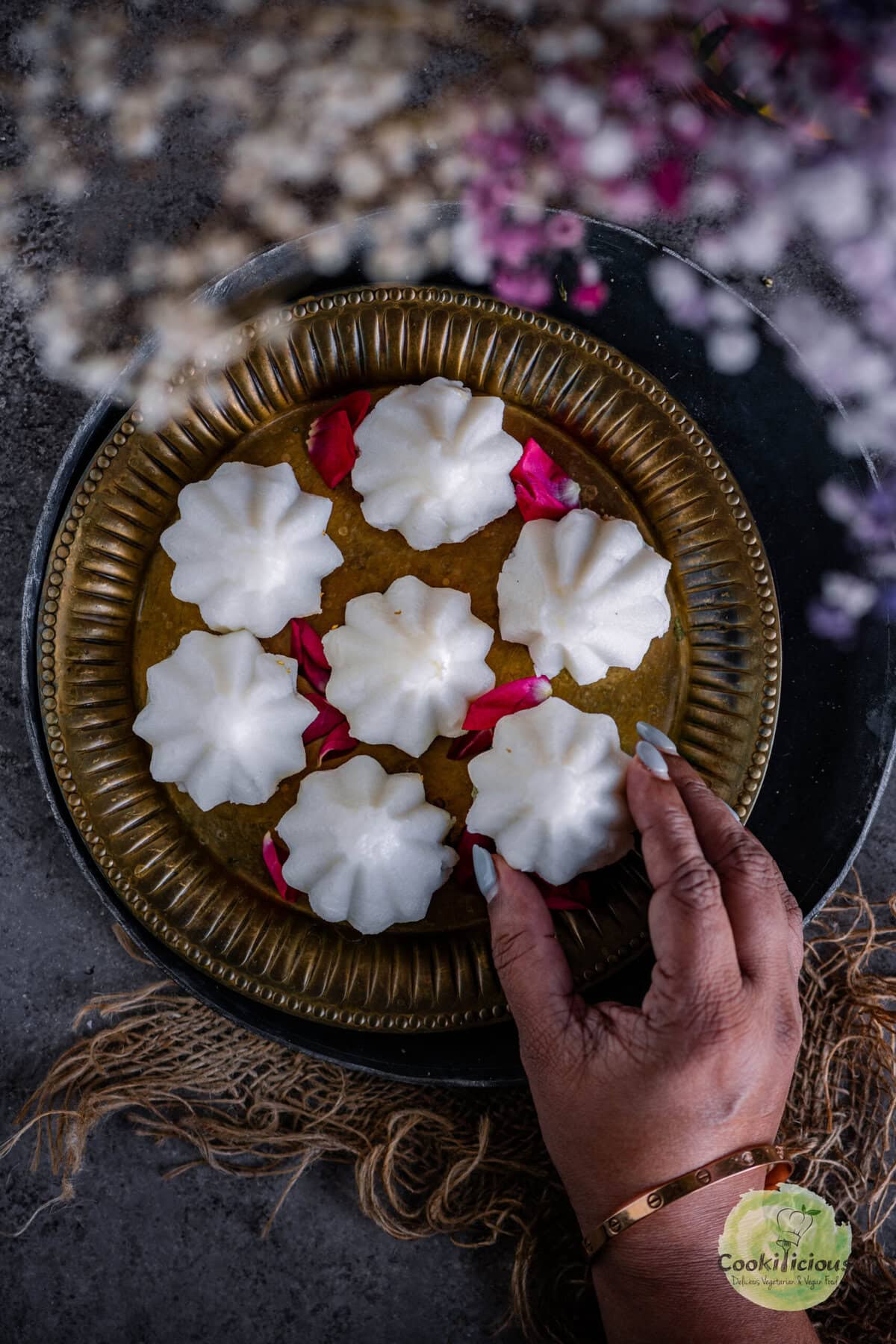
Jump to:
What Is Kozhukattai
Kozhukattai (also spelled Kolukattai, modakam, or mothagam) is a stuffed rice flour dumpling that can be sweet or savory. The sweet version is called Thengai Pooranam Kozhukattai in South India, while in Maharashtra it's known as Ukadiche Modak. In Tamil, Thengai (or thenga) means coconut, pooranam means stuffing, and Kozhukattai is the name for these steamed dumplings. In Marathi, Ukad means "steam" and modak means "sweet dumpling."
This classic Vellai Kozhukattai (vellai means white in Tamil) is the most popular recipe, especially during the 9-day Hindu festival Ganesh Chaturthi (or Vinayaka Chaturthi), which celebrates Lord Ganesha. It's believed that modak is Lord Ganesha's favorite sweet, making it an essential offering during this festival. That's why it's also populary known as Ganpati Modak.
Bringing Back Traditional Kozhukattai for Ganesh Chaturthi
For years, many of you have enjoyed making my Instant Chocolate Modak recipe during Ganesh Chaturthi, but I've always wanted to share our traditional Kozhukattai recipe too - for those who wish to make it the authentic way, just like our moms and grandmoms did. To make this Kolukattai recipe easy and accessible for beginners, I've included step-by-step instructions on how to use special molds to shape these Ganpati modaks easily. Save this Indian sweet dumpling recipe!
I also have another unique Kozhukattai recipe on the blog: Ammini Kozhukattai. Made with traditional Kozhukattai maavu (rice flour dough), Ammini Kozhukattai is a savory snack that's shaped differently and uses a distinct cooking method. This fun bite-sized recipe even went viral on my Instagram!
In many ways, Kozhukattai is quite similar to momos - both are steamed dumplings made with rice flour - but what makes Kozhukattai special is the delicious Thengai Pooranam (coconut jaggery filling) and its deep connection to tradition, devotion, and family memories.
During festivals like Varalakshmi Vratham and Vinayaka Chaturthi (Ganesh Chaturthi), it's customary to prepare Thengai Pooranam Kozhukattai. In many South Indian homes, both savory and sweet Kozhukattai are also made for the monthly Sankatahara Chaturthi. Almost every time we make Kozhukattai, there's some leftover rice flour dough (Kozhukattai maavu), which we turn into delicious bite-sized Ammini Kozhukattai.
Why Make It
- 🌟 This is an authentic South Indian modak recipe
- 🌿 These steamed rice flour dumplings are vegan, gluten-free, and nut-free
- 🎉 It's the most common dessert made during the Indian festival Ganesh Chaturthi
- 🥥 Is made with 4 basic ingredients and with the help of a mold
- ⏱️ Make these steamed rice flour dumplings in just 45 minutes
- 👩🍳 Perfect for beginner cooks and festive celebrations
Ingredients needed 🧾
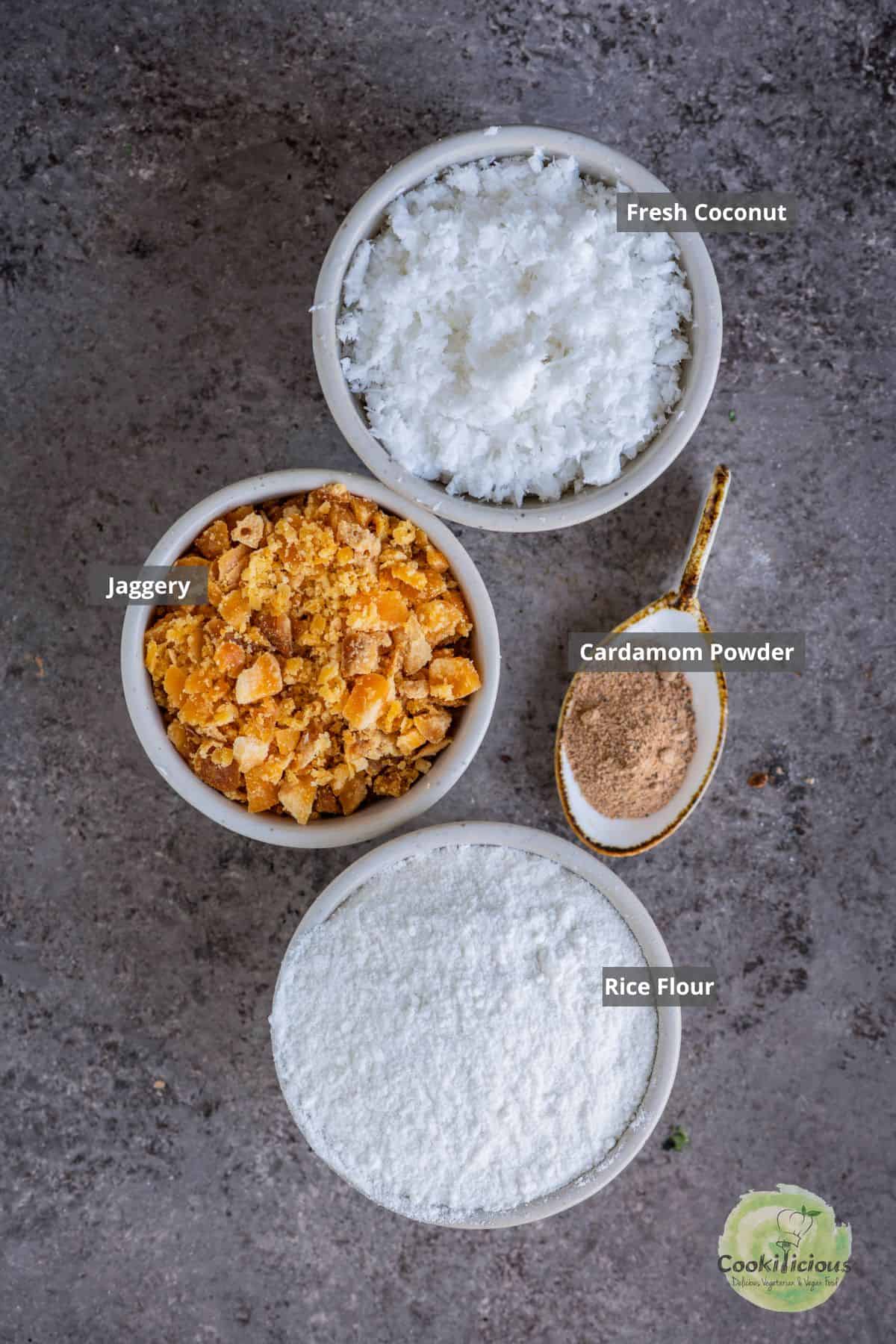
Rice Flour for Modak Dough
I use fine Indian rice flour, ideal for making soft and smooth kozhukattai or steamed modak dough. If your rice flour isn't finely ground, sift it through a fine sieve before use. Alternatively, you can use Idiyappam flour or specialty modak flour / kozhukattai flour available in many Indian grocery stores during festival season. This rice flour dough forms the delicate outer shell for these traditional South Indian sweet dumplings.
Coconut for Modak Filling
Freshly grated coconut is traditionally used to make the sweet Kozhukattai pooranam - the sweet coconut and jaggery stuffing. For convenience, frozen shredded coconut from Indian stores works well; just thaw it for a couple of hours. You can also shred fresh coconut chunks in a blender. Unsweetened desiccated coconut is a good substitute when fresh coconut isn't available, maintaining the authentic flavor of the filling.
Jaggery (Gud) for Sweet Filling
Organic jaggery powder or jaggery chunks are used to sweeten the coconut stuffing in this modagam recipe. Grate or finely chop the jaggery before mixing to ensure it melts evenly, creating the classic sweet filling that makes this Ganesh Chaturthi modak recipe so special.
Cardamom for Authentic Flavor
No traditional Indian dessert recipe is complete without cardamom! Use either cardamom powder or freshly crushed cardamom seeds from whole pods to infuse the filling with its signature warm aroma.
Oil for Modak Dough and Molding
Gingelly oil (Indian sesame oil) is preferred for kneading the Kozhukattai maavu and greasing molds, adding a subtle nutty flavor. Coconut oil, vegan ghee, or regular ghee (for non-vegans) are excellent alternatives that keep the Ganpati modaks moist and flavorful.
Modak Molds for Perfect Shaping
Various modak molds are available in the market, coming in different sizes and styles. Some molds, like the four-slot mold I use for my Instant Chocolate Modak shape multiple modaks at once but are too small for traditional Kozhukattai. For authentic steamed Ganpati modak or Thengai Pooranam Kozhukattai, you'll need larger molds that make shaping and stuffing easier-especially for beginners. You can find these traditional molds at Indian grocery stores like Patel Brothers or online from US-based sellers.
How to make it 🔪
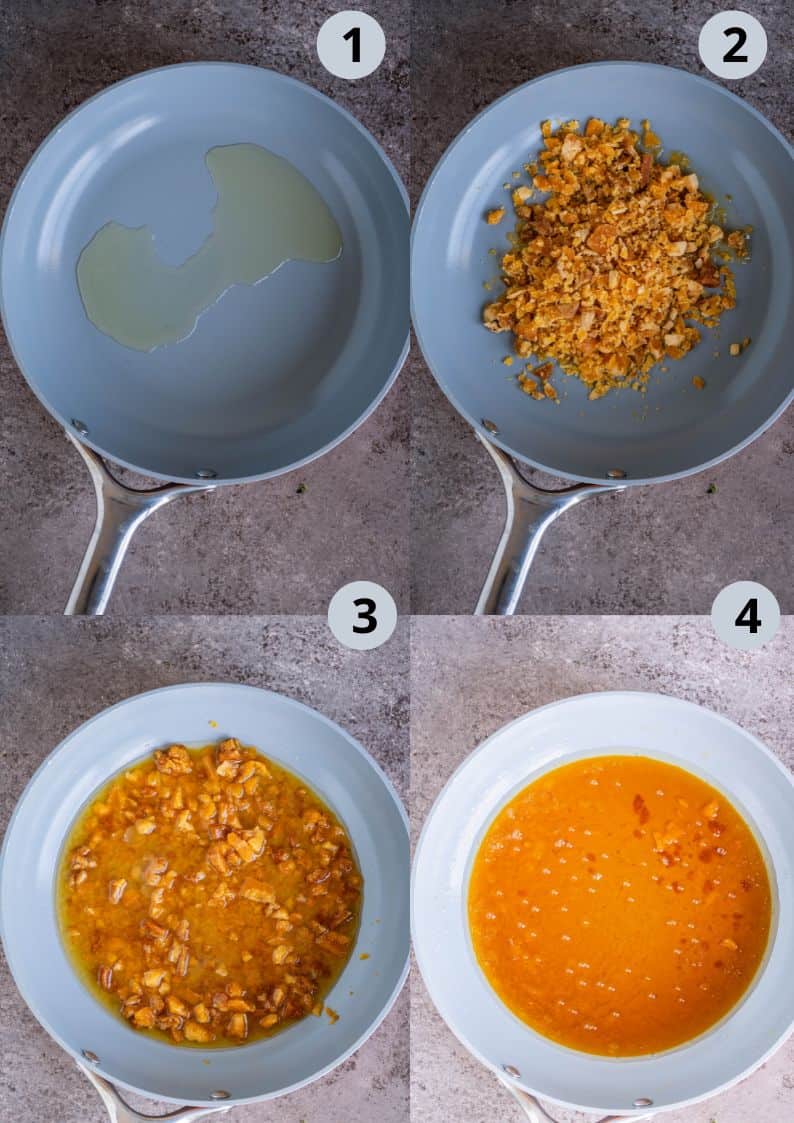
To make the Thengai Pooranam
- Heat a pan and add vegan ghee.
- Once the vegan ghee is hot, add the shredded jaggery.
- Followed by water.
- Stir and cook on medium heat until the jaggery melts completely and it starts to boil- there's no need to cook it to a one-string consistency. If you notice any impurities settling at the bottom, strain the melted jaggery before adding the grated coconut.
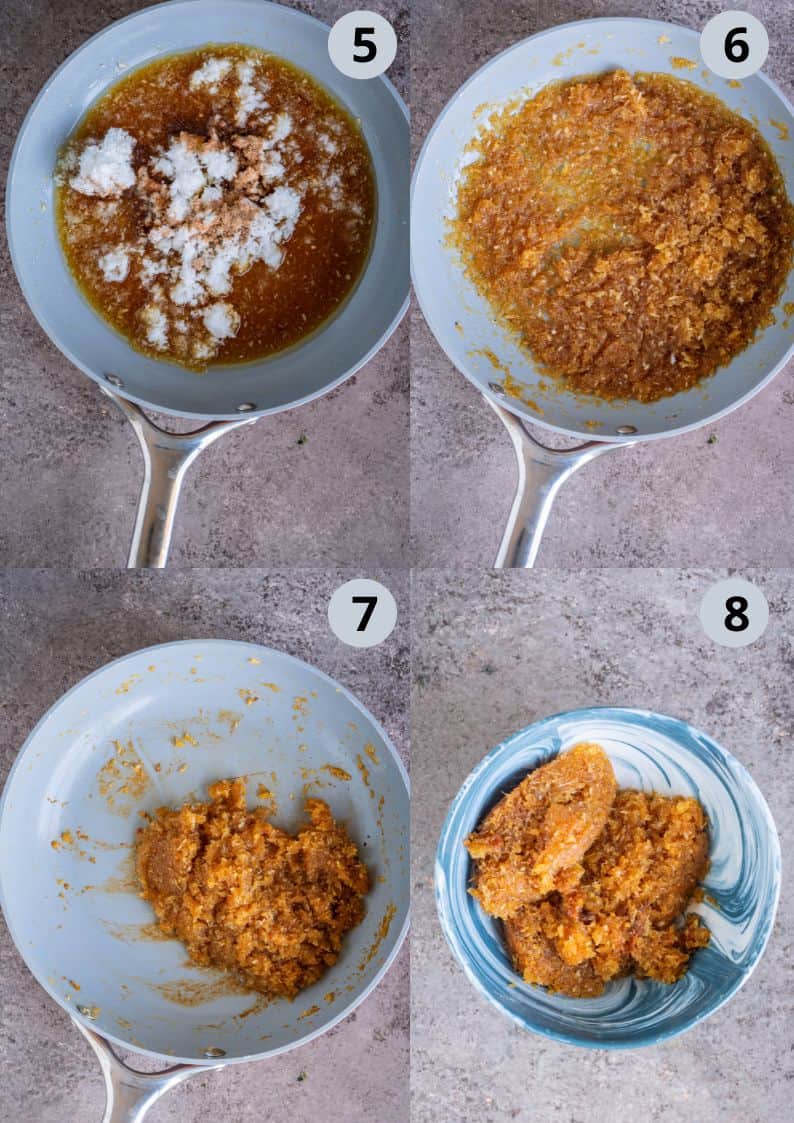
- Add the fresh grated coconut and cardamom powder.
- Mix well and cook for 2-3 minutes, stirring continuously.
- Cook the mixture until it thickens and comes together like a soft dough-moist enough to leave the sides of the pan without sticking. Avoid overcooking, as this will make the pooranam hard. If it does become too firm, sprinkle a little hot water and gently loosen it before using.
- Transfer the Thengai Pooranam (sweet coconut jaggery stuffing) to a bowl and let it cool slightly before using it to fill your modaks or kozhukattai. You can also divide it into equal balls and keep.
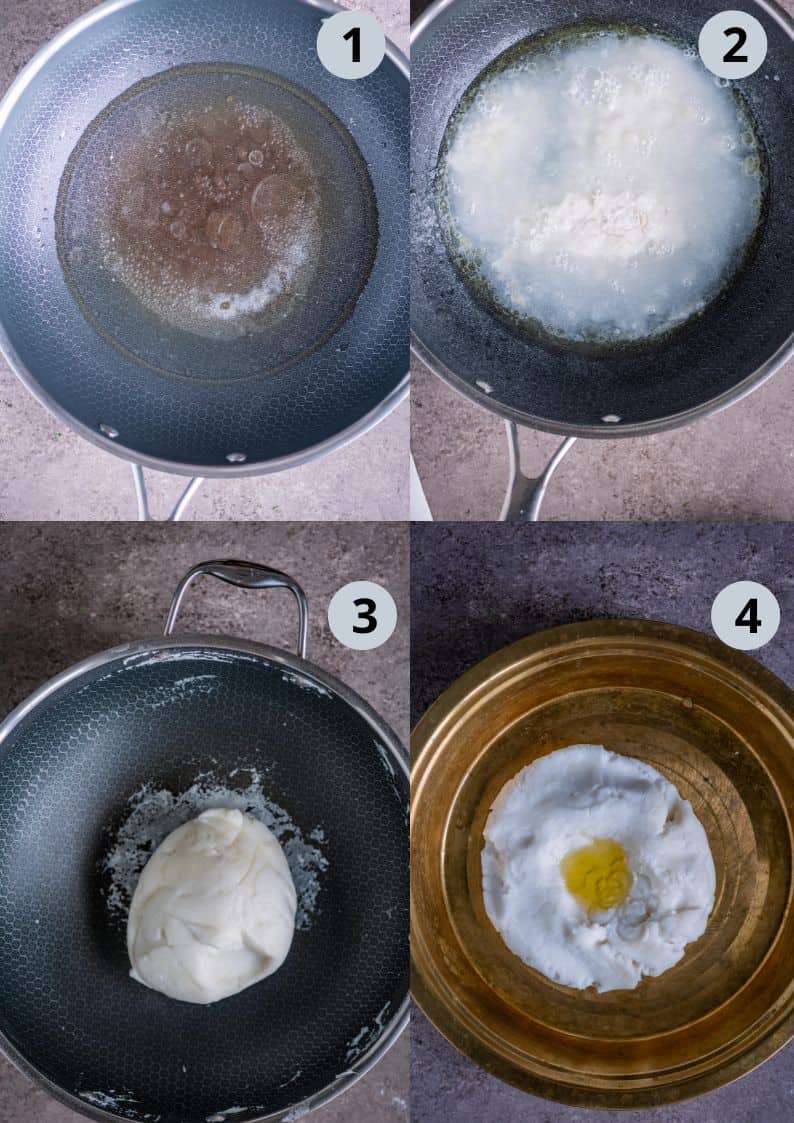
Want to save this recipe?
To make the Kozhukattai Maavu
- In a pan, bring water to a rolling boil, then add salt and 1 tablespoon of gingelly oil.
- Gradually add the rice flour, stirring continuously with a silicone spatula or whisk to prevent lumps. Add more hot water only if needed.
- Keep stirring on medium flame for 2-3 minutes until the mixture thickens, stops sticking to the pan, and forms a soft dough.
- Transfer the Kozhukattai maavu to a plate and let it cool slightly. Add 1 tablespoon of gingelly oil and start to knead it while still warm (not hot) to remove any lumps.
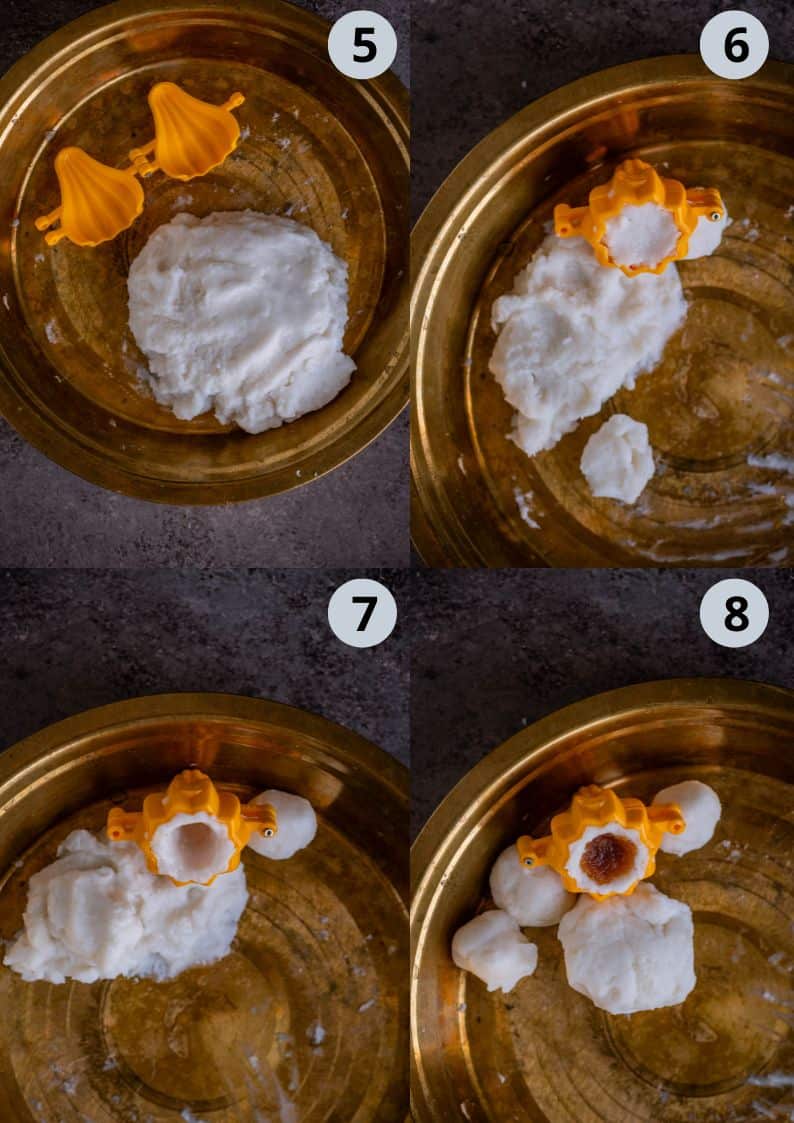
To prepare the Kozhukattai
- Knead the rice flour dough until it's smooth, soft, and pliable - this is a key step for perfect modak or kozhukattai. If the dough is still hot, sprinkle some water in your palms and then knead. Add more oil if needed while kneading. Divide into lemon-sized balls if you prefer. Always cover the dough with a moist cloth or damp paper towel to prevent it from drying out. Clean the modak mold and lightly grease it with a little gingelly oil (sesame oil). This helps the modaks release easily and gives them a neat shape.
- Close the mold and gently press a portion of the rice flour dough inside.
- Using your clean fingers, spread the dough evenly along the sides of the mold to form a hollow cavity. Make sure to press it into all the corners to get the classic modak shape - but don't make the outer shell too thin or too thick.
- Fill the cavity generously with the prepared Thengai Pooranam (sweet coconut jaggery stuffing). Be mindful that the dough layer shouldn't be too thick - balance the ratio of the soft outer shell and the sweet filling for the best-tasting Kozhukattai.
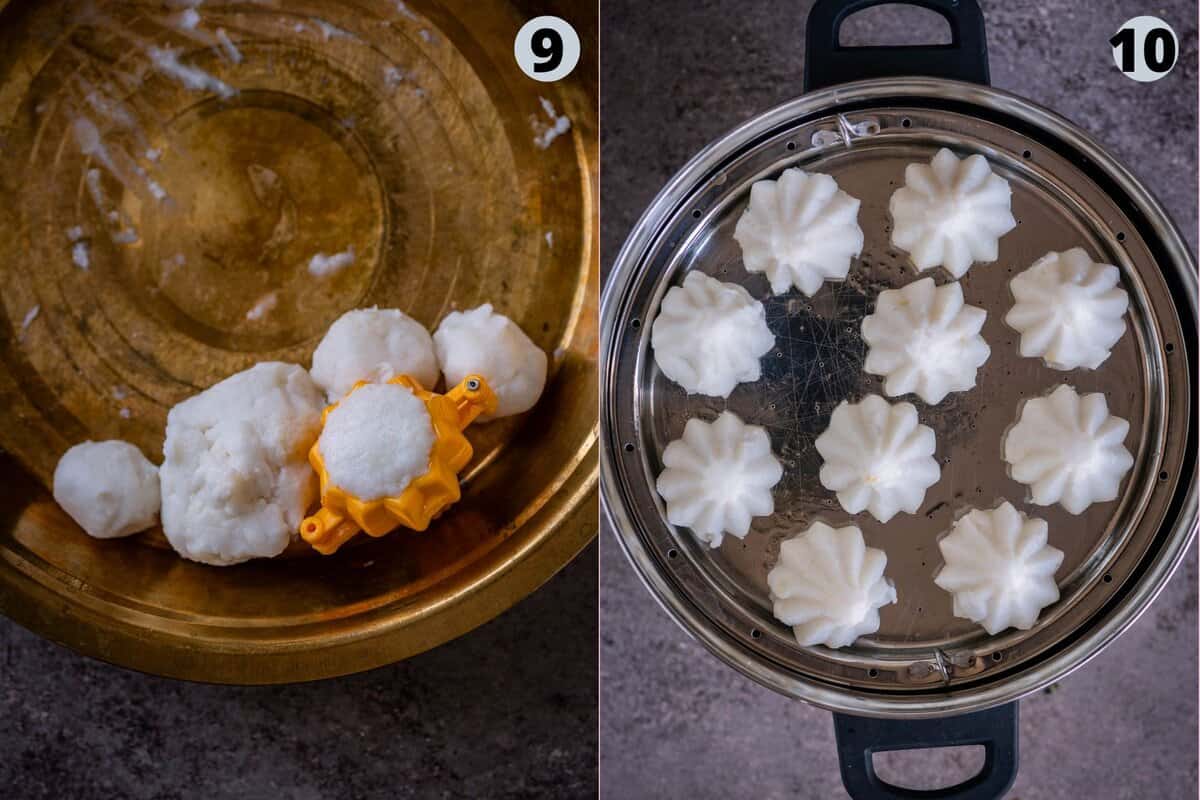
- Add a small portion of dough on top to seal the base firmly. Gently open the mold and carefully remove the shaped modak. If needed, reshape the tip with your fingers. If you see little cracks, smoothen the covering with wet fingers. Place the modak on a plate. Keep these covered as well to prevent them from drying. Repeat the process with the remaining maavu and pooranam. Keep greasing your hands and the modak mold with gingelly oil as you work - this prevents sticking and helps shape the modaks smoothly.
- Place the stuffed modaks on a greased steamer plate, making sure they don't touch each other - leave enough space between them to prevent sticking while steaming. Add 2 cups of water to the Steamer. Place the steamer plate in it and steam the Thengai Kozhukattai for about 10-12 minutes on medium flame. Once done, let the steamer cool naturally. Then open and carefully transfer the steamed modaks to a plate. You'll know your steamed kozhukattais are perfectly cooked when they look glossy and their color changes slightly - that's your sign they're perfectly cooked and ready to serve!
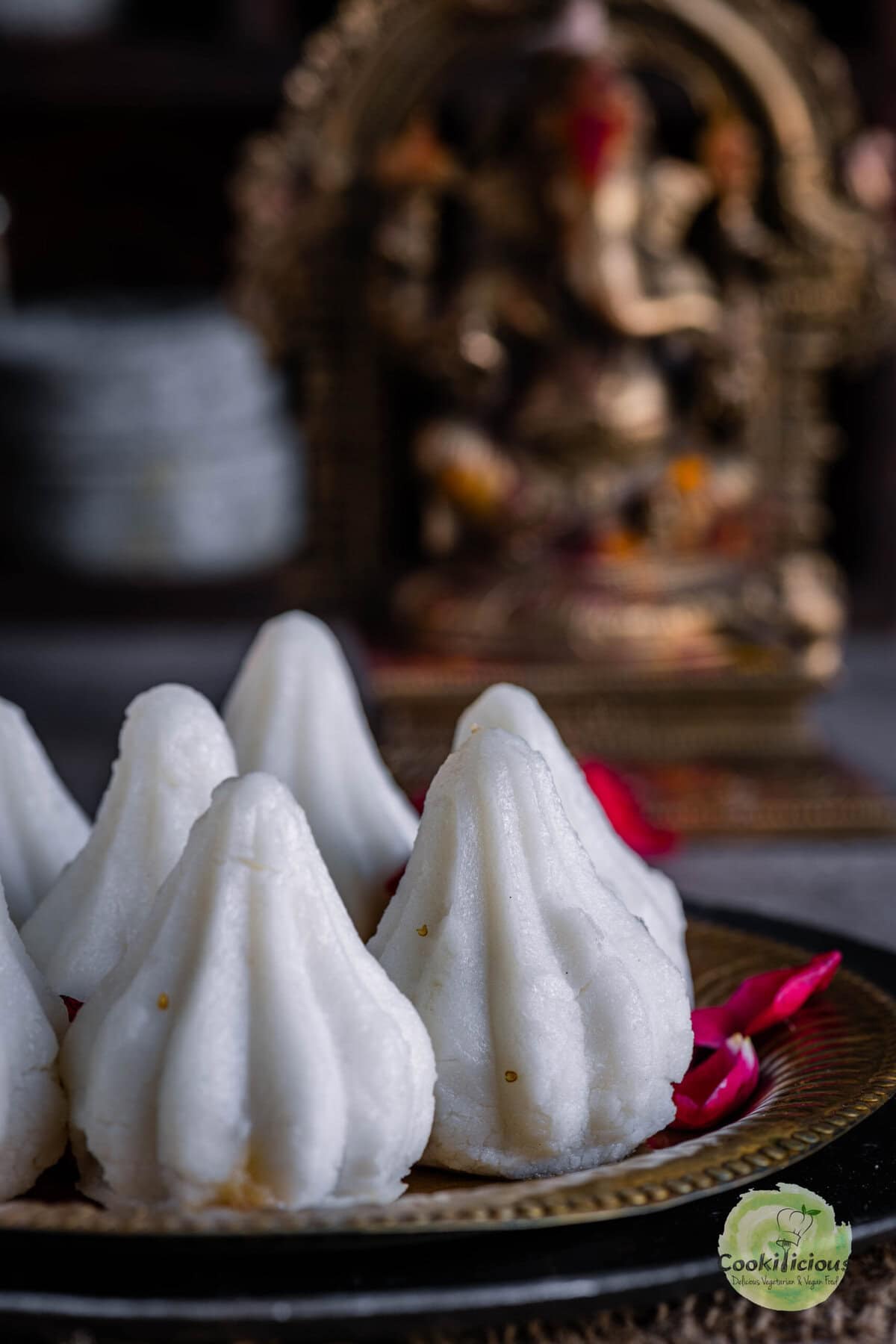
Serving suggestions 🍽
Thengai Pooranam Kozhukattai tastes best when served warm. For extra richness, drizzle some warm vegan ghee on top just before serving. For a festive touch, soak a few strands of saffron in warm milk and gently pour it over these vegan modaks. You can also garnish it with edible rose petals or sprinkle of edible camphor (optional) - some families do this for traditional flavor.
Serve these delicious coconut modaks as prasadam or neividhyam (offerings to God) during Ganesh Chaturthi, Vinayaka Chaturthi, Varalakshmi Vratham, or Nombu. These modakams also make a perfect sweet snack to enjoy after the pooja, paired beautifully with a cup of traditional South Indian Filter Coffee or your favorite warm beverage.
Ganesh Chaturthi Menu
Besides these steamed rice flour dumplings, traditional dishes like Lemon Rice, Coconut Rice, Avial, Potato Fry, Vazhakai Poriyal, Sambar, Patra, Mor Kuzhambu, Puri, Mango Kadhi, Sundal, Paruppu Sevai, Puliyogare, Rose Basundi, Caramel Kalakand, Seviyan Kheer, and Paal Payasam make a perfect addition to your Ganesh Chaturthi festival menu.
Top recipe tips 💭
You can make colorful Ukadiche Modaks by adding natural or organic food coloring to the rice flour dough-this makes them look even more festive and fun for Ganesh Chaturthi. The number of modaks you get will depend on the size of your molds and how generously you fill them. Always be generous with the coconut-jaggery stuffing; if you add too little, the modak will have too much dough and not enough sweet filling, which can affect the taste and texture. While jaggery is the traditional sweetener for this Ukadiche Modak recipe, you can use brown sugar or dates as an alternative if needed.
FAQs 📖
Traditionally, Ukadiche modaks were made without molds. My mom, grandmom, and mother-in-law always shaped Kozhukattai by hand. It takes a bit of practice and patience, and while the modaks may not look perfectly uniform, the taste is what truly matters!
Here's a simple way to shape modaks without a mold:
Once the rice flour dough has cooled enough to handle, divide it into small lemon-sized portions.
Flatten each portion gently into a small disc with the help of a rolling pin.
Place a spoonful of the coconut jaggery filling (Thengai Pooranam) in the center of the disc.
Carefully fold the edges of the disc up around the filling, pinching and pleating the dough to form a shape similar to dumplings or momos.
Bring the pleats together at the top to create a cone-shaped modak. Remove the excess mixture at the top.
Remember to grease your hands with a little oil while working with the dough to prevent sticking.
If shaping a traditional modak is tricky, you can also form them into simpler shapes like semicircles (half-moons), stuffed balls, or samosas-these taste just as delicious!
Every household has its own traditional twist on making modak. While the classic stuffing typically includes grated coconut, jaggery, and cardamom, some families add additional spices like poppy seeds, chopped nuts, and nutmeg to enhance the flavor.
For a richer texture and taste, some recipes incorporate cooked lentils such as chana dal, or add gulkand, mawa, dry fruits, sesame seeds (til/ellu) and peanuts either along with or instead of coconut in the filling.
Regarding the dough, the traditional choice is rice flour, but you can experiment with other flours to create different textures and flavors. Options include whole wheat flour, all-purpose flour (maida), rava (semolina), idli rava, puttu podi, raw rice flour, or even millet flours like ragi flour. Each variation offers a unique twist on the classic Ukadiche Modak or kozhukattai.
Start by sieving the rice flour if needed to ensure it's fine and lump-free. If the rice flour dough feels too sticky after cooking, cover and simmer it on low flame for 1-2 minutes to firm up slightly. Once it cools, knead in some gingelly oil (Indian sesame oil) to make it soft and pliable.
Always cover the dough with a damp cloth to prevent it from drying out. If it dries, it will crack while shaping the modaks. Cracking indicates the dough is too dry-simply sprinkle a little hot water and knead it gently to restore the right consistency. Avoid using dry or hard dough, as this will cause the kozhukattai to crack or the filling to pop out during steaming, resulting in a tough texture.
The Thengai Pooranam (coconut-jaggery filling) should also be just right-not too moist or wet-so it holds together well without making the modak soggy. Maintaining the right balance of softness and moisture in both the Kolakattai maavu and the filling is key to making perfect Thengai Pooranam Kozhukattai. Additionally, avoid overcooking when steaming the modaks, as this can cause them to become rubbery instead of soft and tender.
For steaming Thengai Pooranam Kozhukattai, I've often used an idli steamer, just like my mom did. You can also use a vegetable steamer, an Instant Pot, or an Indian pressure cooker-but be sure to steam without the whistle to avoid over-pressurizing.
If you're using an Instant Pot, here's how to steam the modaks perfectly:
Add 2 cups of water to the steel insert.
Select Sauté mode and bring the water to a boil.
Place a tall trivet inside, then carefully set a steel pan or steamer basket on top.
Arrange the modaks in the pan, ensuring they don't touch each other.
Close the lid and keep the valve in the vent position.
Select Steam mode and steam the modaks for 10-12 minutes. Use an external timer for accuracy.
Once done, let 5 minutes pass, then carefully lift the valve to release any remaining pressure before opening the lid.
This method ensures your Ukadiche modaks cook evenly, retaining their soft, melt-in-the-mouth texture.
You don't need a traditional steamer to make Ukadiche Modak or Thengai Pooranam Kozhukattai at home. An easy method is to use a large pot. Simply add about 2 cups of water and bring it to a boil. Place a trivet or stand inside the pot and set a steel or heatproof plate on top. Arrange the shaped modaks on the plate, making sure they don't touch each other, then cover the pot with a tight-fitting lid and steam for about 10 minutes until they look glossy and are cooked through.
If you don't want to steam, you can also fry the modaks using a whole wheat flour covering.
Another alternative is to bake the Kozhukattai. Prepare the modak recipe as mentioned here - coconut-jaggery stuffing and the rice flour dough as usual, shape the modaks, then lightly spray them with cooking oil or brush them with milk for a golden finish. Preheat your oven to 350°F (180°C) and bake for about 20-25 minutes, or until they turn golden brown. Baking or frying is a great way to enjoy this festive sweet even if you don't have a steamer on hand! When baked, these modaks turn slightly crisp outside, like a stuffed pastry - delicious with a cup of chai!
Yes! Fried modaks are made using a different dough-typically whole wheat flour is used for the outer covering. The modaks are stuffed with the sweet coconut-jaggery filling and then either shallow or deep-fried until golden and crisp. This is the traditional Maharashtrian way of making fried modak, and it happens to be my favorite!
I grew up enjoying these delicious fried modaks, thanks to my Maharashtrian neighbors who introduced me to this delightful variation. Some even take it a step further by steaming the modaks first before frying, which adds an extra layer of softness inside.
The coconut-jaggery stuffing (Thengai Pooranam) can be prepared a day in advance and stored in the refrigerator. However, if you're making modaks for pooja or as prasadam, it's always best to prepare everything fresh.
Leftover rice flour maavu can be repurposed to make Ammini Kozhukattai or even turned into savory modaks using an urad dal pooranam filling. Leftover Thengai Pooranam can also be used creatively to make Puranpoli or even layered into Baklava for a fusion twist.
Leftover steamed Kozhukattai can be kept at room temperature in an airtight container for up to a day. After that, store them in the fridge in an airtight container for 3-4 days. When ready to enjoy, reheat the Ukadiche Modak in the microwave for 1-2 minutes until soft.
It's best not to freeze steamed modaks, as they may become dry or chewy once thawed.
More Easy Indian Festive Sweets
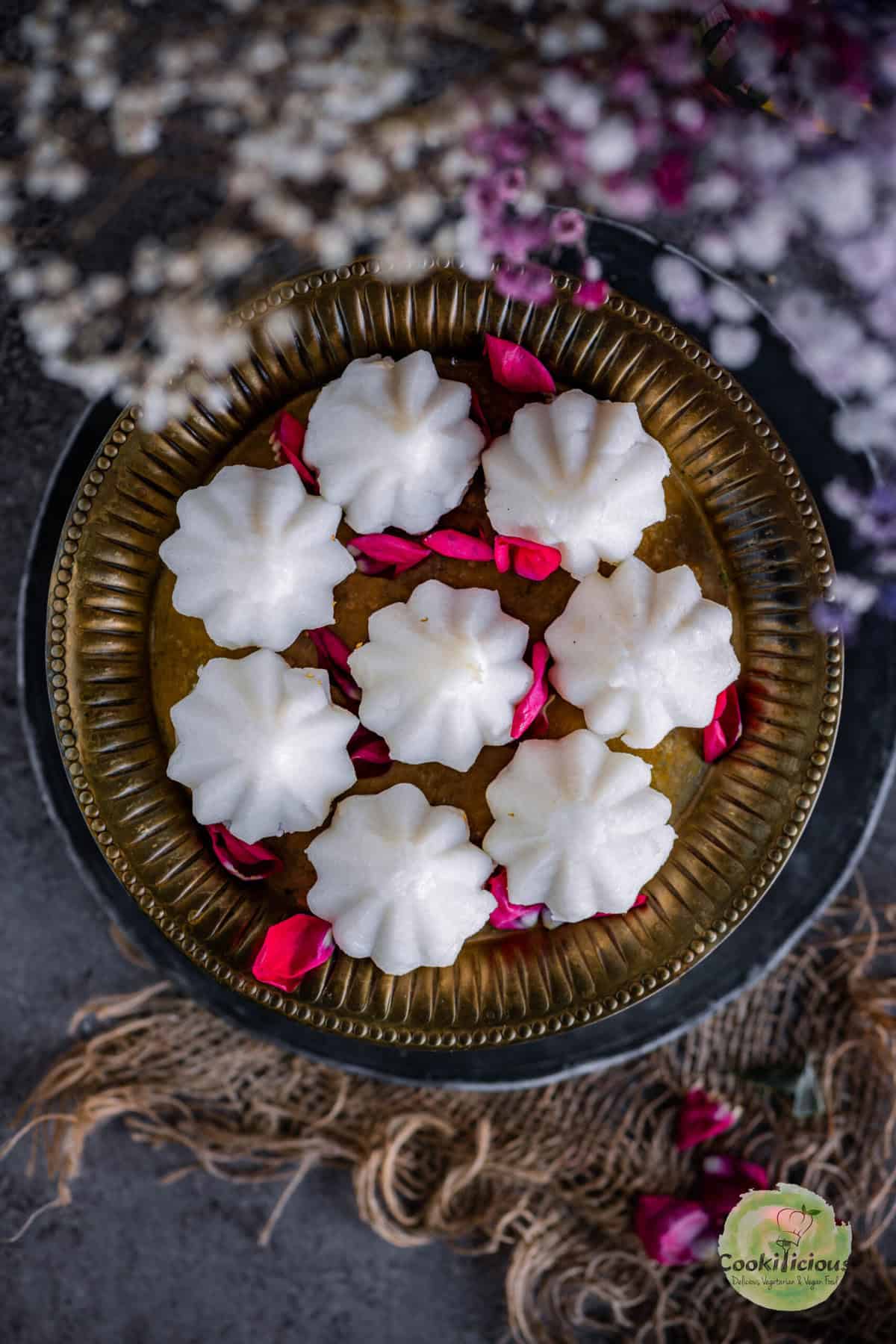
⭐️ Subscribe to the Cookilicious Newsletter and receive new recipes straight to your inbox! You'll receive my FREE Vegan Beginner's guide as a gift. Ready to elevate your cooking game? Purchase my Cookbook - The Essential Vegan Indian Cookbook today!
Recipe 📖
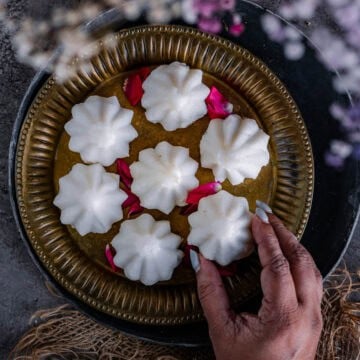
Authentic Modak Recipe | Steamed Thengai Poorana Kozhukattai
Equipment
Ingredients
To Make The Thengai Pooranam
- 1 tablespoon vegan ghee
- ½ cup jaggery, shredded
- ¼ cup water
- 1 cup grated coconut
- 1 teaspoon cardamom powder
To Make The Kozhukattai Maavu
- 1 cup rice flour
- 2 cups water
- ⅛ teaspoon salt
- 1 tablespoon gingelly oil
Instructions
To Make The Thengai Pooranam
- Heat a pan and add vegan ghee.
- Once the vegan ghee is hot, add the shredded jaggery.
- Followed by water.
- Stir and cook on medium heat until the jaggery melts completely and it starts to boil- there's no need to cook it to a one-string consistency. If you notice any impurities settling at the bottom, strain the melted jaggery before adding the grated coconut.
- Add the fresh grated coconut and cardamom powder.
- Mix well and cook for 2-3 minutes, stirring continuously.
- Cook the mixture until it thickens and comes together like a soft dough-moist enough to leave the sides of the pan without sticking. Avoid overcooking, as this will make the pooranam hard. If it does become too firm, sprinkle a little hot water and gently loosen it before using.
- Transfer the Thengai Pooranam (sweet coconut jaggery stuffing) to a bowl and let it cool slightly before using it to fill your modaks or kozhukattai. You can also divide it into equal balls and keep.
To Make The Kozhukattai Maavu
- In a pan, bring water to a rolling boil, then add salt and 1 tablespoon of gingelly oil.
- Gradually add the rice flour, stirring continuously with a silicone spatula or whisk to prevent lumps. Add more hot water only if needed.
- Keep stirring on medium flame for 2-3 minutes until the mixture thickens, stops sticking to the pan, and forms a soft dough.
- Transfer the Kozhukattai maavu to a plate and let it cool slightly. Add 1 tablespoon of gingelly oil and start to knead it while still warm (not hot) to remove any lumps.
To Prepare The Kozhukattai
- Knead the rice flour dough until it's smooth, soft, and pliable - this is a key step for perfect modak or kozhukattai. If the dough is still hot, sprinkle some water in your palms and then knead. Add more oil if needed while kneading. Divide into lemon-sized balls if you prefer. Always cover the dough with a moist cloth or damp paper towel to prevent it from drying out. Clean the modak mold and lightly grease it with a little gingelly oil (sesame oil). This helps the modaks release easily and gives them a neat shape.
- Close the mold and gently press a portion of the rice flour dough inside.
- Using your clean fingers, spread the dough evenly along the sides of the mold to form a hollow cavity. Make sure to press it into all the corners to get the classic modak shape - but don't make the outer shell too thin or too thick.
- Fill the cavity generously with the prepared Thengai Pooranam (sweet coconut jaggery stuffing). Be mindful that the dough layer shouldn't be too thick - balance the ratio of the soft outer shell and the sweet filling for the best-tasting Kozhukattai.
- Add a small portion of dough on top to seal the base firmly. Gently open the mold and carefully remove the shaped modak. If needed, reshape the tip with your fingers. If you see little cracks, smoothen the covering with wet fingers. Place the modak on a plate. Keep these covered as well to prevent them from drying. Repeat the process with the remaining maavu and pooranam. Keep greasing your hands and the modak mold with gingelly oil as you work - this prevents sticking and helps shape the modaks smoothly.
- Place the stuffed modaks on a greased steamer plate, making sure they don't touch each other - leave enough space between them to prevent sticking while steaming. Add 2 cups of water to the Steamer. Place the steamer plate in it and steam the Thengai Kozhukattai for about 10-12 minutes on medium flame. Once done, let the steamer cool naturally. Then open and carefully transfer the steamed modaks to a plate. You'll know your steamed kozhukattais are perfectly cooked when they look glossy and their color changes slightly - that's your sign they're perfectly cooked and ready to serve! Thengai Pooranam Kozhukattai tastes best when served warm.

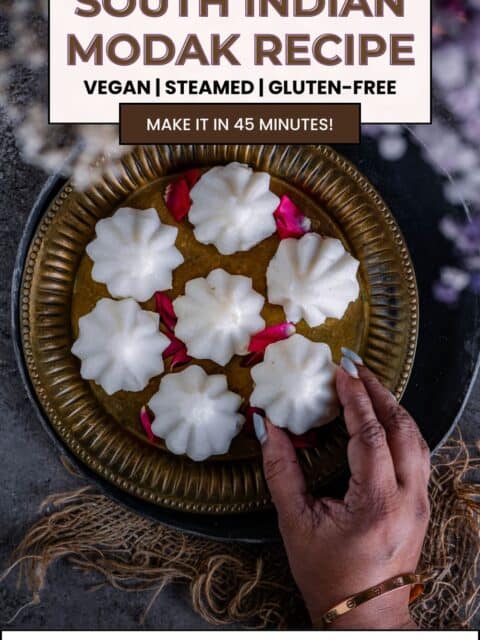

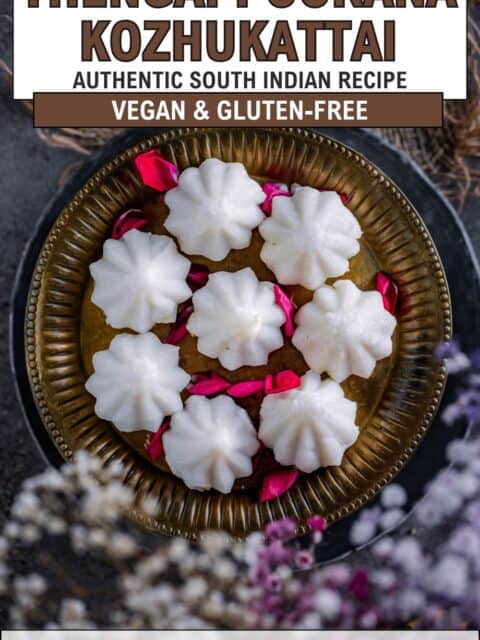

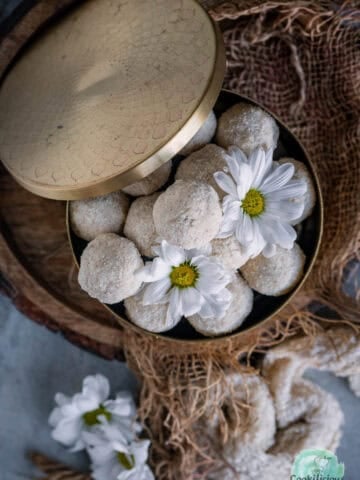



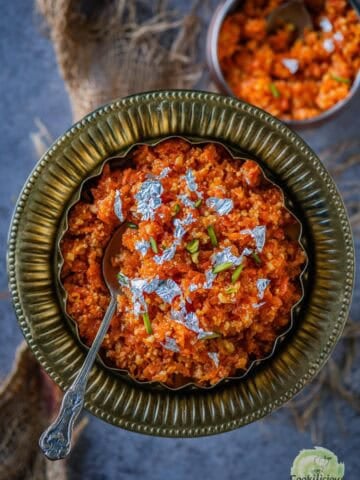

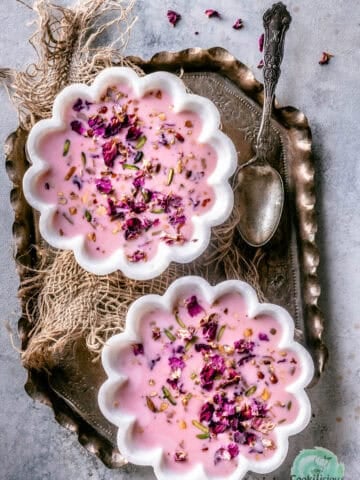
Leave a Reply